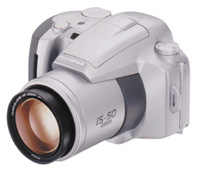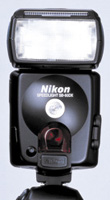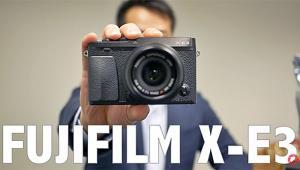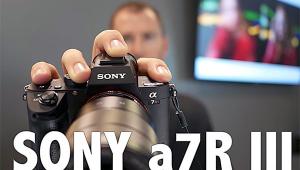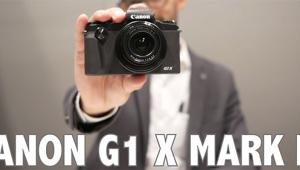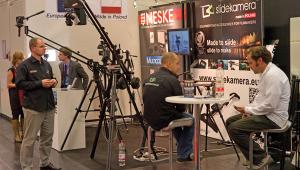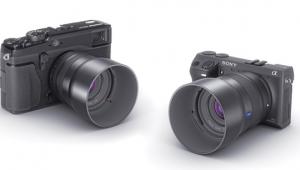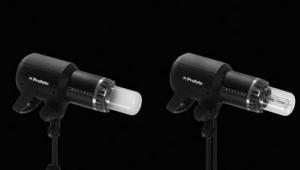35mm SLR Cameras And Flash Units
Described by one trade magazine as a "digital lovefest," this year's PMA show did not produce many film-based SLR cameras. Even so, I did find several new models, as well as some new flash units, with ultrahigh tech capabilities. As in past years, the trend is toward smaller and lighter autofocus SLR cameras, with controls that are more intuitive for simpler, more convenient operation. Of course, the traditional "back to basics" cameras are still alive and well, with one manufacturer announcing three such models. Affordable Autofocus Cameras
The Contax NX As a mid-range model, the Contax NX does not offer a multitude of Program modes, but does include one, plus the semiautomatic and manual options. Three metering patterns (including evaluative) are available, as well as overrides such as autoexposure bracketing. Other features include the five-point autofocus system of the N1, focus assist beam, 2.3 fps motorized film advance, 20 custom functions, high eyepoint viewfinder, plus a socket for electronic cable release. Designed for simplicity of operation, the camera includes a mode selector dial on its left "shoulder" plus a rear-mounted command dial for controlling shutter speeds and various functions. The viewfinder and external LCD panel provide extensive data as to settings and modes, essential in an advanced camera. (Street Price: $650.) The Pentax ZX-L |
|
The ZX-L includes only evaluative metering, adequate for most needs. When used with manual focus lenses, center-weighted metering is provided instead. Employing the SAFOX IV autofocus system with three sensors, the camera allows for quick off-center framing; the single central sensor can be selected, too. Continuous focus is activated when the system detects subject motion. Other niceties include a multimode flash head that automatically pops up in some modes, diopter correction eyepiece, 11 custom functions, and a terminal for an optional remote control unit. Considering the many capabilities, the Pentax ZX-L offers very good value for the money. (List Price: $400.) Pentax also introduced an entry-level camera, the ZX-60, intended for those on a tight budget. Even smaller and lighter (11.8 oz vs. 13.6 oz) this model does not include all of the capabilities of the ZX-L. Specifically, it's missing the custom functions, exposure compensation control, diopter correction eyepiece, depth of field preview control, and terminal for an optional remote control unit. As well, the ZX-60 incorporates a wide single-point AF sensor (not three point) and has a two-zone evaluative metering system (not six zone). Although it may sound like a point-and-shoot camera, the ZX-60 does offer a Manual mode plus two semiautomatic options as well as autoexposure bracketing. These features do allow the user to control exposure, depth of field, and the depiction of motion. Because the Pentax ZX-60 targets the first-time SLR buyer, it has simplified controls and also offers less data in the viewfinder. These factors should help to minimize any confusion. While some entry-level SLR cameras are loaded with features, there's definitely a market for an uncomplicated model. Anyone first moving up from a point-and-shoot camera should love this Pentax SLR. The list price of the body is $250, and you should be able to buy the ZX-60 in a kit, with a 28-90mm zoom lens, for under $349. That makes it competitive with the high-end lens/shutter cameras, while offering far more options for anyone who wants to progress beyond snapshooting. |
|
Nikon's N55 The built-in multimode flash is adequately powerful (Guide Number of 39 in feet, at ISO 100) and pops up automatically in some Program modes. With this flash or a suitable accessory Speedlight, the camera offers Matrix Balanced Fill Flash. Borrowing technology from the pro F5, the N55 includes Dynamic Autofocus with Closest Subject Priority for high reliability with all subject types. The camera switches automatically into focus tracking when subject motion is detected. If you want constant tracking focus for instant response, set the Sports Program. Automatic focus point selection is provided, but any of three focus detection sensors can be selected for pinpoint control. (Street Price: $319.) |
|
Olympus "ZLR" Cameras The new Olympus IS-5 Deluxe is a camera with a sleek design and large handgrip for convenient use. However, its 28-140mm f/4.9-6.9 lens, with multi-coated optics, is particularly noteworthy. Aside from a wide range of focal lengths, it features an ELD (Extra-Low Dispersion) glass element for superior image quality at longer focal lengths. The minimum focus distance is a very short 2 ft at wide angle and in Macro mode. The camera offers a full range of operating modes just like many SLR cameras: five Program modes, plus Manual and semiautomatic modes. It even includes three metering options: evaluative, spot, and center-weighted plus exposure compensation control. Panorama format and eyepiece diopter correction are also included. Like the SLR cameras, this ZLR model includes a passive autofocus system; for moving subjects, it provides continuous predictive AF, but only in the Action Program mode. In low light, a burst of flash provides focus assist. The multimode flash system is highly versatile. It includes two separate flash tubes, increasing the range at telephoto lens settings. In sunny conditions, fill flash is provided; indoors, the camera activates Auto Color-Balancing Flash that automatically detects and responds to fluorescent light. Finally, high-speed flash sync to 1/2000 sec is available in some modes, a first for a built-in flash unit. At 20.8 oz--including lens and powerful built-in flash--this is a lightweight and highly portable camera. (It does accept accessory flash as well.) It's also simple to operate, thanks to a very large LCD panel with symbols that are easy to decipher. (List Price: $449.) The new Olympus IS-50 is a similar camera with a 28-120mm f/4.9-6.8 ED lens, but with fewer features. This model omits the shutter priority AE mode, some of the data in the viewfinder and the panorama frame mode. As well, its Manual operating mode is intended only for long exposures. However, the IS-50 is even simpler to operate and more affordable than the IS-5, so it should become just as popular. (List Price: $349.) |
|
Manual Focus SLRs |
|
Phoenix already offered the fully manual P1 and the P2 with limited automation. Joining this line-up are three new Phoenix models with polycarbonate exterior and Minolta MD mount. (Later this year, they should also be available with K mount.) All are made in China by the manufacturer of the Seagull twin lens reflex cameras. The P-2000 is a fully manual model reminiscent of the Minolta X370; it offers center-weighted metering and LED displays in the viewfinder. The shutter speed range is 1 to 1/1000 sec; a T and B setting for long exposures (without metering guidance) can also be selected. This body is sold in a kit with a 28-80mm f/3.5-5.6 zoom and genuine leather case. (Street Price: under $250.) The P-3000 is a very similar model but includes Aperture Priority AE mode and accepts the optional Phoenix P-3000 Power Winder for motorized film advance at up to 2 fps. (Street Price: under $300 with lens and case; winder: under $75.) The top of the line model is the P-5000, with stylish, futuristic curves that increase its appeal. This model accepts the optional P-5000 Power Winder, designed by the German company, Colani; the winder's curves match those of the camera. Similar in features to the P-3000, the P-5000 camera is said to have a more sophisticated center-weighted metering system. It's sold in a kit, with a 50mm f/1.8 lens and leather case. (Street Price: $275.) |
|
High Tech Flash Units Pentax also released the first of a new series of FGZ flash units, the AF360FGZ. Like the earlier FTZ-series models, the FGZ flash includes many capabilities, such as the standard TTL and non-TTL Auto modes. One significant new feature is the flash exposure compensation control, very useful for reducing flash output in sunny conditions. This unit also offers Modeling Flash for evaluating flash placement and off-camera flash photography with several flash units, connected with TTL cables. Other major upgrades are available only with the latest Pentax cameras: the ZX-L, the MZ-S, and future Pentax cameras. First is high-speed flash sync, useful with fast film or with nearby subjects at wide lens apertures. Wireless off-camera TTL flash is also available, for remote flash without a tangle of connecting cords. However, the most significant new capability of the AF360FGZ is the P-TTL flash metering mode, with the ZX-L and MZ-S body. When P-TTL mode is selected, it fires a pre-flash burst before the actual exposure. In conjunction with the camera's multi-segment light sensor, the flash meter measures subject distance and brightness as well as the background exposure. The resulting data is calculated for setting just the right flash output. P-TTL flash is available with any AF lens so you don't need to buy new lenses; however, it will operate only in Program modes and in Shutter Priority AE mode. This technology should be more successful with subjects including an ultra-bright area: such as a bride in white among groomsmen in black tuxes, or a bright reflection from a framed picture in the background. Both high-speed flash sync and flash exposure compensation can be used in Wireless mode, in P-TTL flash. (List price: $332.) |
|
Nikon has upgraded their top of the line flash unit: the new SB-80DX AF Speedlight replaces the older SB-28 and SB-28DX. Fully compatible with the many high tech flash capabilities of Nikon film and digital SLR cameras, this unit includes all of the numerous features of its predecessors, plus some extras. The most significant of these include: zooming 24-105mm head, eight custom settings to tailor the flash unit to personal preferences, more advanced Wireless Flash capabilities, expanded flash exposure compensation range (+/- 3 EV), modeling flash to preview flash effects and a more powerful focus-assist illuminator (useful for subjects up to 33 ft from the camera). This is a large and hefty (11.8 oz) Speedlight with high power output (GN 125 at 35mm setting) and is among the most advanced of any model currently on the market. Sporting an entirely new "multi-selector" thumb pad that replaces some buttons, the SB-80DX offers convenient operation. Aside from the built-in 14mm wide angle adapter, Nikon includes a new "soft dome" diffuser accessory that provides very soft, directionless lighting effects. (List Price: $510.) Not everyone needs a high powered flash unit, or all of the advanced capabilities of the SB-80DX. That's why Nikon also released the new SB-30, an ultra compact (almost tiny) model weighing only 3.2 oz. This one would be ideal for those who own cameras without built-in flash or for those who own certain CoolPix digital cameras. The SB-30 is unobtrusive, especially if folded down when not in use. Do note that this is not a DX-series model, so it does not offer TTL flash metering with the D-series digital cameras; non-TTL Auto mode can be used, however. Its Guide Number of 52 (in feet at ISO 100 at the 28mm setting) is modest, but this accessory is more powerful than most built-in flash units. It offers several significant features, too: downward tilt for close-up shooting, 17mm adapter for ultra-wide angle photography, and a new locking system that assures positive contact with the camera's hot shoe. The SB-30 can also be used as a remote flash unit in wireless flash photography, or as a trigger for other off-camera Speedlights. Offering TTL, non-TTL, and Manual mode, it is also fully compatible with the high tech systems of Nikon's high-end conventional cameras, such as 3D Multi-Sensor Matrix Balanced Fill Flash. (List Price: $115.) |




